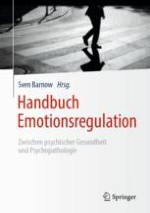Zusammenfassung
Dieses Kapitel gibt eine Übersicht über Definition, Konzepte und Modelle von Emotion und Emotionsregulation (ER). Dabei werde ich näher auf folgende Fragen eingehen: 1) Was versteht man unter Emotion, Emotionsgenerierung und ER, und wie sind diese Prozesse miteinander assoziiert? 2) Welche ER-Strategien werden beschrieben, und welche theoretischen Modelle existieren hierzu? 3) Ist es sinnvoll, ER-Strategien bezüglich ihrer Wirksamkeit in adaptiv versus maladaptiv zu klassifizieren, und welche Bedeutung hat u. a. die Kontextsensitivität hierbei? 4) Was versteht man unter einer flexiblen (adaptiven) ER? Abschließend stelle ich ein integratives Modell flexibler ER vor und diskutiere die klinischen Implikationen und Herausforderungen an die zukünftige Forschung.

